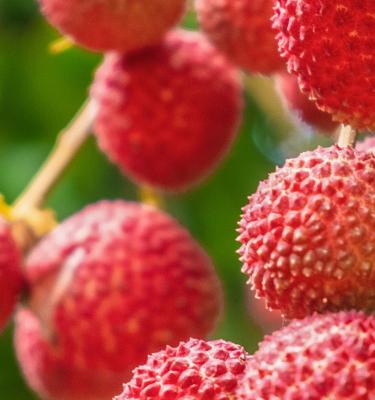

The Ultimate Guide to Growing Lychee
Lychee fruit grow on medium to large evergreen trees that love growing in subtropical and tropical climates. They love a full sun position, in a spot with protection from high winds. Lychee trees will begin cropping 3-5 years after planting, but they’ll produce their biggest crops around 10 years old - so you’ll need to be patient!
Lychee trees are self-pollinating, so you only need 1 tree to produce fruit. However, to get the best fruit formation, they need cooler nights (below 20 degrees) for several weeks to ensure a good balance of male and female flowers form.
5 top tips for growing lychee trees
- Choose a full sun position, sheltered from strong winds or you can grow lychees in a large pot.
- Lychee trees are attractive 3-5 metre tall evergreen trees and you only need 1 to produce a crop.
- Your biggest crops of lychee will occur around 10 years after planting, however smaller crops will begin 3-5 years after planting - depending on the variety.
- Harvest lychees when their skin has turned completely red or pink (depending on the variety), lychees will not ripen off the tree.
- Lychee trees prefer a soil that is slightly acidic, so use fertiliser (and potting mix if growing in pots) that’s designed for acid loving plants like Scotts Osmocote Plus Organics Roses, Gardenias & Azaleas Plant Food & Soil Improver
Essential shopping list for growing lychee trees
- A lychee tree
- Scotts Osmocote Compost Premium Soil Improver
- Scotts Osmocote Plus Organics Roses, Gardenias & Azaleas Plant Food & Soil Improver
- If growing in pots, Scotts Osmocote Rose, Gardenia, Azalea & Camellia Potting Mix and a suitable pot
- Garden spade
- Mulch
- Secateurs
- Wildlife safe crop protection netting
Prepare
Lychee trees prefer a full sun spot in a well drained soil, with protection from strong winds.
Prepare the soil for planting your lychee tree by digging a hole that’s twice as wide as the root ball of your tree and the same depth.
Loosen the soil at the bottom of the hole and mix Scotts Osmocote Compost Premium Soil Improver and Scotts Osmocote Plus Organics Roses, Gardenias & Azaleas Plant Food & Soil Improver through the original soil.
How to plant lychee trees in the garden
Growing lychee from bare-rooted or potted trees
Bare-rooted lychee trees can be purchased and planted in late autumn or winter. Potted lychees can be purchased year round, but avoid planting them in the peak of summer.
Plant your lychee tree at the same depth it was in the pot or if bare-rooted make sure it’s sitting at the same height it would have been when in the ground. If needed, create a mound in your prepared planting hole to sit the root ball on so it’s at the correct height.
Add a stake to support bare-rooted trees at planting - this can be removed once the roots have taken. It’s also a good idea to protect young lychee trees from wind damage with a plant protection ring made from 3-star pickets and shade cloth. This can be removed once the plant is 2-3 years old and well established.
Firm down the soil around the roots of your newly planted lychee tree and water it well. Top dress around the tree with an open mulch to suppress weeds and retain moisture.
Lightly prune lychee trees after they’ve finished fruiting to keep at a manageable height
Fertilise in spring and again in autumn with Scotts Osmocote Plus Organics Roses, Gardenias & Azaleas Plant Food & Soil Improver.
Growing lychee in pots
Lychee trees can be grown in pots - choose a pot that is at least 400-500mm wide by the same depth. An old half-wine barrel with drainage holes added is an ideal size.
Half your pot with a premium potting mix suited to acid-loving plants like Scotts Osmocote Rose, Gardenia, Azalea & Camellia Potting Mix. Then carefully remove your lychee tree from its nursery pot or bag (if bare-rooted) and plant it into the centre of the pot. Fill in around the root ball with more potting mix.
Firm down the potting mix around your newly planted tree in the pot and water it in well to settle its roots in.
Mulch around your new potted lychee tree to retain moisture and ensure the pot can be easily watered during the summer months.
Lychee harvest
Lychee are ready for harvest anywhere from November to March, when the fruit colour changes to pink or red. The colour of the skin and the timing of harvest will depend on your location and the variety you’ve chosen. Fruits will be sweetest if harvested in the morning.
Use secateurs to cut the fruits from the tree in bunches to avoid damaging the skin. And remember once harvested lychee will not ripen off the tree.
You may need to securely net your trees to protect the crop from hungry birds and other animals. Once the fruits have formed, use a wildlife safe, 4mm hole or smaller white netting that’s pulled tightly over the tree and secured around the truck or set up a frame structure over the tree so you can easily place the net over this.
Common lychee tree diseases & pests
If Queensland Fruit Fly are a pest in your area you may need to net with insect exclusion netting once the fruit have started to form.



